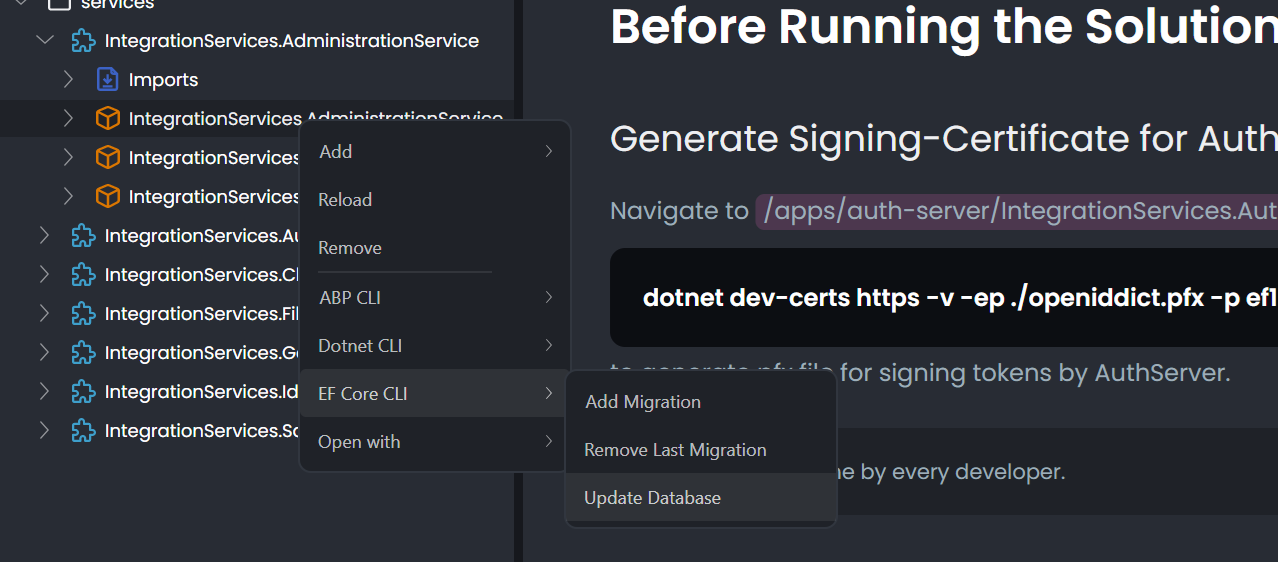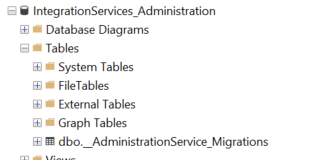- ABP Framework version: v8.1
- UI Type: Angular
- Database System: EF Core (SQL Server,)
- Tiered (for MVC) or Auth Server Separated (for Angular): yes
- Exception message and full stack trace:
- Steps to reproduce the issue:
I am now using AbpIo for a new project and I am using the Micro Service templates. But this time I am using SQL Server instead of mysql in the past. I used the Abp Studio and created the template and then changed all the connection strings to the below :
"Administration": "Server=localhost; User Id=sa1; Password=myPassw@rd; Database=IntegrationServices_Administration; TrustServerCertificate=true",
"AuditLoggingService": "Server=localhost; User Id=sa1; Password=myPassw@rd; Database=IntegrationServices_AuditLoggingService; TrustServerCertificate=true",
"SaasService": "Server=localhost; User Id=sa1; Password=myPassw@rd; Database=IntegrationServices_SaasService; TrustServerCertificate=true",
"AbpBlobStoring": "Server=localhost; User Id=sa1; Password=myPassw@rd; Database=IntegrationServices_BlobStoring; TrustServerCertificate=true"
I also tried the above with a remote sql server as well instead of localhost. I even tried with Trusted Connection. I have been trying every permutation and combination of the connection string to get this running however of no use.
I also made sure the credentials I am using is correct by logging into the sql server as well. I check every settings in SQL to make sure everything is turned on. I have been using this same database seerver to run one of my projects based out of ASPNETZero, so I don't think there is any issue with the connection string.
No matter how i do it I end up getting the below error :
Cannot open database "IntegrationServices_Administration" requested by the login. The login failed.
Login failed for user 'sa'.. Stack Trace:
at Microsoft.Data.SqlClient.SqlInternalConnection.OnError(SqlException exception, Boolean breakConnection, Action`1 wrapCloseInAction)
at Microsoft.Data.SqlClient.TdsParser.ThrowExceptionAndWarning(TdsParserStateObject stateObj, Boolean callerHasConnectionLock, Boolean asyncClose)
at Microsoft.Data.SqlClient.TdsParser.TryRun(RunBehavior runBehavior, SqlCommand cmdHandler, SqlDataReader dataStream, BulkCopySimpleResultSet bulkCopyHandler, TdsParserStateObject stateObj, Boolean& dataReady)
at Microsoft.Data.SqlClient.TdsParser.Run(RunBehavior runBehavior, SqlCommand cmdHandler, SqlDataReader dataStream, BulkCopySimpleResultSet bulkCopyHandler, TdsParserStateObject stateObj)
at Microsoft.Data.SqlClient.SqlInternalConnectionTds.CompleteLogin(Boolean enlistOK)
at Microsoft.Data.SqlClient.SqlInternalConnectionTds.AttemptOneLogin(ServerInfo serverInfo, String newPassword, SecureString newSecurePassword, Boolean ignoreSniOpenTimeout, TimeoutTimer timeout, Boolean withFailover)
at Microsoft.Data.SqlClient.SqlInternalConnectionTds.LoginNoFailover(ServerInfo serverInfo, String newPassword, SecureString newSecurePassword, Boolean redirectedUserInstance, SqlConnectionString connectionOptions, SqlCredential credential, TimeoutTimer timeout)
at Microsoft.Data.SqlClient.SqlInternalConnectionTds.OpenLoginEnlist(TimeoutTimer timeout, SqlConnectionString connectionOptions, SqlCredential credential, String newPassword, SecureString newSecurePassword, Boolean redirectedUserInstance)
at Microsoft.Data.SqlClient.SqlInternalConnectionTds..ctor(DbConnectionPoolIdentity identity, SqlConnectionString connectionOptions, SqlCredential credential, Object providerInfo, String newPassword, SecureString newSecurePassword, Boolean redirectedUserInstance, SqlConnectionString userConnectionOptions, SessionData reconnectSessionData, Boolean applyTransientFaultHandling, String accessToken, DbConnectionPool pool)
at Microsoft.Data.SqlClient.SqlConnectionFactory.CreateConnection(DbConnectionOptions options, DbConnectionPoolKey poolKey, Object poolGroupProviderInfo, DbConnectionPool pool, DbConnection owningConnection, DbConnectionOptions userOptions)
at Microsoft.Data.ProviderBase.DbConnectionFactory.CreatePooledConnection(DbConnectionPool pool, DbConnection owningObject, DbConnectionOptions options, DbConnectionPoolKey poolKey, DbConnectionOptions userOptions)
at Microsoft.Data.ProviderBase.DbConnectionPool.CreateObject(DbConnection owningObject, DbConnectionOptions userOptions, DbConnectionInternal oldConnection)
at Microsoft.Data.ProviderBase.DbConnectionPool.UserCreateRequest(DbConnection owningObject, DbConnectionOptions userOptions, DbConnectionInternal oldConnection)
at Microsoft.Data.ProviderBase.DbConnectionPool.TryGetConnection(DbConnection owningObject, UInt32 waitForMultipleObjectsTimeout, Boolean allowCreate, Boolean onlyOneCheckConnection, DbConnectionOptions userOptions, DbConnectionInternal& connection)
at Microsoft.Data.ProviderBase.DbConnectionPool.WaitForPendingOpen()
--- End of stack trace from previous location ---
at Microsoft.EntityFrameworkCore.Storage.RelationalConnection.OpenInternalAsync(Boolean errorsExpected, CancellationToken cancellationToken)
at Microsoft.EntityFrameworkCore.Storage.RelationalConnection.OpenInternalAsync(Boolean errorsExpected, CancellationToken cancellationToken)
at Microsoft.EntityFrameworkCore.Storage.RelationalConnection.OpenAsync(CancellationToken cancellationToken, Boolean errorsExpected)
at Microsoft.EntityFrameworkCore.Storage.RelationalConnection.BeginTransactionAsync(IsolationLevel isolationLevel, CancellationToken cancellationToken)
at Microsoft.EntityFrameworkCore.Storage.RelationalConnection.BeginTransactionAsync(CancellationToken cancellationToken)
at Volo.Abp.Uow.EntityFrameworkCore.UnitOfWorkDbContextProvider`1.CreateDbContextWithTransactionAsync(IUnitOfWork unitOfWork)
at Volo.Abp.Uow.EntityFrameworkCore.UnitOfWorkDbContextProvider`1.CreateDbContextAsync(IUnitOfWork unitOfWork)
at Volo.Abp.Uow.EntityFrameworkCore.UnitOfWorkDbContextProvider`1.CreateDbContextAsync(IUnitOfWork unitOfWork, String connectionStringName, String connectionString)
at Volo.Abp.Uow.EntityFrameworkCore.UnitOfWorkDbContextProvider`1.GetDbContextAsync()
at Volo.Abp.Domain.Repositories.EntityFrameworkCore.EfCoreRepository`2.GetDbSetAsync()
at Volo.Abp.Domain.Repositories.EntityFrameworkCore.EfCoreRepository`2.GetQueryableAsync()
at Volo.Abp.Domain.Repositories.EntityFrameworkCore.EfCoreRepository`2.GetListAsync(Boolean includeDetails, CancellationToken cancellationToken)
at Castle.DynamicProxy.AsyncInterceptorBase.ProceedAsynchronous[TResult](IInvocation invocation, IInvocationProceedInfo proceedInfo)
at Volo.Abp.Castle.DynamicProxy.CastleAbpMethodInvocationAdapterWithReturnValue`1.ProceedAsync()
at Volo.Abp.Uow.UnitOfWorkInterceptor.InterceptAsync(IAbpMethodInvocation invocation)
at Volo.Abp.Castle.DynamicProxy.CastleAsyncAbpInterceptorAdapter`1.InterceptAsync[TResult](IInvocation invocation, IInvocationProceedInfo proceedInfo, Func`3 proceed)
at Volo.Abp.PermissionManagement.DynamicPermissionDefinitionStore.UpdateInMemoryStoreCache()
at Volo.Abp.PermissionManagement.DynamicPermissionDefinitionStore.EnsureCacheIsUptoDateAsync()
at Volo.Abp.PermissionManagement.DynamicPermissionDefinitionStore.GetPermissionsAsync()
at Volo.Abp.Authorization.Permissions.PermissionDefinitionManager.GetPermissionsAsync()
at IntegrationServices.AdministrationService.Data.AdministrationServiceDataSeeder.SeedAdminPermissionsAsync(Nullable`1 tenantId) in C:\SourceCode\integration-microservices\services\administration\IntegrationServices.AdministrationService\Data\AdministrationServiceDataSeeder.cs:line 67
at IntegrationServices.AdministrationService.Data.AdministrationServiceDataSeeder.SeedAsync(Nullable`1 tenantId) in C:\SourceCode\integration-microservices\services\administration\IntegrationServices.AdministrationService\Data\AdministrationServiceDataSeeder.cs:line 41
at IntegrationServices.AdministrationService.Data.AdministrationServiceRuntimeDatabaseMigrator.SeedAsync() in C:\SourceCode\integration-microservices\services\administration\IntegrationServices.AdministrationService\Data\AdministrationServiceRuntimeDatabaseMigrator.cs:line 35
at Volo.Abp.EntityFrameworkCore.Migrations.EfCoreRuntimeDatabaseMigratorBase`1.LockAndApplyDatabaseMigrationsAsync()
at Volo.Abp.EntityFrameworkCore.Migrations.EfCoreRuntimeDatabaseMigratorBase`1.LockAndApplyDatabaseMigrationsAsync()
at Volo.Abp.EntityFrameworkCore.Migrations.EfCoreRuntimeDatabaseMigratorBase`1.TryAsync(Func`1 task, Int32 maxTryCount)
2024-09-17 17:44:04.214 -07:00 [INF] Trying to acquire the distributed lock for database migration: Administration.
2024-09-17 17:44:04.249 -07:00 [INF] Distributed lock is acquired for database migration: Administration...
2024-09-17 17:44:15.183 -07:00 [INF] Seeding admin permissions.
2024-09-17 17:44:15.282 -07:00 [ERR] An error occurred using the connection to database 'IntegrationServices_Administration' on server 'localhost'.
2024-09-17 17:44:16.671 -07:00 [WRN] SqlException has been thrown. The operation will be tried 1 times more. Exception:
Note : I commented out the SQL for docker and using the SQL from my local system , rest all the docker infrastructure is working as the same.
I am using Multi Tenancy as well, if that helps with anything.
I suspect something else is wrong. I have sent the link with the code for administration micro service just fro you to understand and debug the issue .shiwei.liang@volosoft.com shiwei.liang@volosoft.com
5 Answer(s)
-
0
Hi,
I guess these databases do not exist yet. You need to run dbmigrator to create them
-
0
Yes the database do not exists and when we run any microservice solution it should create the database automatically.
Doesn't this line of code expected to do that :
public override async Task OnPreApplicationInitializationAsync(ApplicationInitializationContext context) { using var scope = context.ServiceProvider.CreateScope(); await MigrateDatabase(scope.ServiceProvider); }However we used the Abp Studio to run the Migration as we get the below error
0:20:44.265 Information Starting task execution: "Updating the database: IntegrationServices.AdministrationService"20:22:24.503 Information CLI command executed. Command: "dotnet ef database update" Working directory: "C:\SourceCode\integration-microservices\services\administration\IntegrationServices.AdministrationService" CommandResult { ExitCode: 1, IsSuccess: False, StartTime: 09/17/2024 20:20:44 -07:00, ExitTime: 09/17/2024 20:22:24 -07:00, RunTime: 00:01:40.2136695 } 20:22:24.505 Information Failed task execution: "Updating the database: IntegrationServices.AdministrationService" 20:22:24.505 Information ERROR: "An error has occured!" 20:22:24.505 Information ERROR DETAILS: "Failed to update database in project IntegrationServices.AdministrationService" 20:22:24.505 Warning Exception of type 'Volo.Abp.Studio.AbpStudioException' was thrown. 20:22:24.507 Warning Code:AbpStudio:EfCoreUpdateDatabaseFailed 20:22:24.507 Warning Details: 20:22:24.507 Warning ---------- Exception Data ---------- ProjectName = IntegrationServices.AdministrationService<br> Then i went ahead and tried toe apply migration like the below
dotnet ef database update --project IntegrationServices.AdministrationService --context AdministrationServiceDbContextNo migrations were applied. The database is already up to date.
When I went to the database this is what I see , only the migration history table gets created when the code is getting built :
I am very confused how things should work, you mentioned run the migrator, where is the migrator project , it doesn't come by default.
We never had such issues while using MySQL, why the process will be any different and if its different what's the correct process. I am doubting it may be to do with the code template or somehwere in the code, have you tried the project i sent you
-
0
microservice solution it should create the database automatically.
yes, the microservices will create database.
No migrations were applied. The database is already up to date. When I went to the database this is what I see , only the migration history table gets created when the code is getting built :
I guess there are no db migrations files?
you can create it manually
dotnet ef migrations add Initial -c .... -
0
Thank You and that was the cause of the issue. There should be a troubleshooting guide for this, the Abp Studio is in Beta and doesn't work at times properly, like migration not getting created. You should put a guide on things to watch out when you create a project for the first time
-
0
Hi,
we will



























































